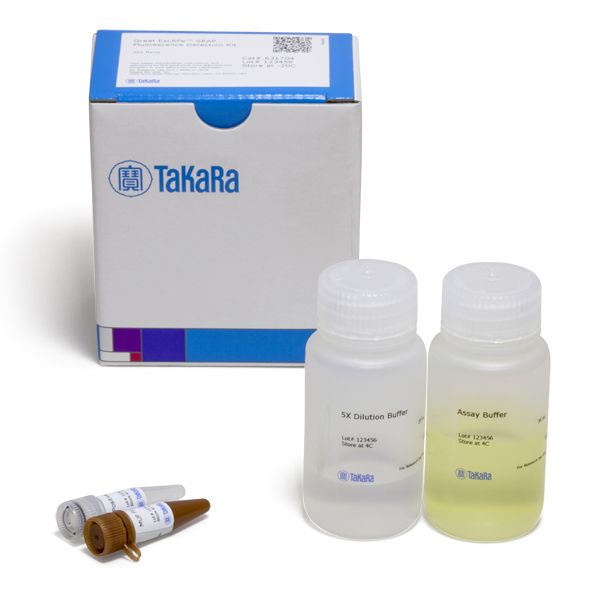SEAP Fluorescence Detection Kit
SEAP Fluorescence Detection Kit
The Great EscAPe SEAP Fluorescence Detection Kit is a complete system for the detection of secreted alkaline phosphatase (SEAP) activity in conditioned media from cultures of mammalian cells expressing this enzyme. The kit contains reagents necessary for the detection of this enzyme activity using the fluorescent substrate 4-methylumbelliferyl phosphate (MUP).
Overview
- One step assay, for monitoring promoter activity
- 10-fold higher sensitivity then firefly luciferase
- No-cell-lysis protocol
- Adaptable from single-tube to high-throughput assays
- Dual, live-cell assay includes secreted luciferase as well as SEAP:
monitor two promoters, or use one reporter as a normalization control
Applications
- Time-course studies
- Non-invasive reporter gene assays with secreted alkaline phosphatase
- Test multiple compounds
- Perform downstream experiments with the same cells
- Use the dual assay (which includes secreted luciferase, as well a secreted alkaline phosphatase assay) to monitor two promoters
- Use the dual assay to monitor one promoter with a built-in normalization control
SEAP activity is highly specific, with a >20-fold increase in activity

SEAP activity is highly specific, with a >20-fold increase in activity. HEK 293 cells were transiently transfected with a promoter construct containing CRE driving the expression of SEAP, or mock-transfected. 12 hr posttransfection, the cell culture media was replaced by media containing either 10 μM forskolin or plain cell culture media and incubated for 7 hr. Forskolin causes an increase in the level of cytosolic cAMP, which in turn activates CRE, driving the expression of SEAP, which is detectable in the media culture supernatant. The samples were assayed using the Great EscAPe SEAP Chemiluminescence Kit 2.0 and its protocol and analyzed on a BD Monolight 3096 Luminometer.
Comparison of the sensitivities of SEAP and firefly luciferase

Comparison of the sensitivities of SEAP and firefly luciferase. Parallel cultures of BHK cells were transiently transfected with the indicated amounts of either pSEAP2-Control Vector or a similar vector expressing luciferase. After 24 hr, SEAP activity was assayed in the appropriate culture media using the Great EscAPe chemiluminescent assay. Similarly, after 24 hr, cell lysates were prepared from the luciferase cultures, and luciferase activity was assayed using a commercial kit. RLU = relative light units.
Signal transduction kits are available for in vivo studies of signal transduction—from signaling cascades to gene transcription

Signal transduction kits are available for in vivo studies of signal transduction—from signaling cascades to gene transcription.


